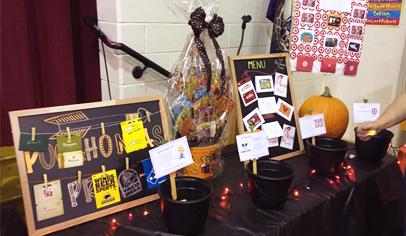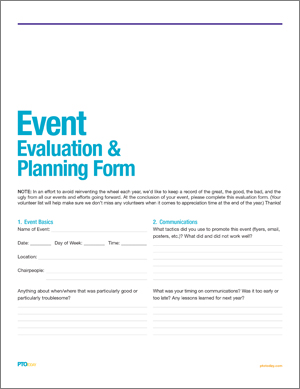Event Planning for PTOs: Five Steps

How to produce a big event without forgetting the little details.
Planning a school event seems simple enough. Organize fun activities, distribute a flyer, get a DJ, put out some food...done. But the devil is in the details, and it’s important to stay organized. Here’s a five-step event planning success strategy, starting with developing your initial idea to evaluating the event after it’s over.
1. Develop the Idea
You may be in charge of running the same event that takes place every year. Or you may have an idea for something completely new. Either way, the first step is to prepare a plan to present to the PTO or PTA for approval and funding.
To maximize input, try to organize a planning committee to refine and improve the plan. Ideally, you want to involve someone who’s been at the school for a while and can provide perspective on what events have worked well in the past, and why. She may be able to advise you on the best pricing, timing, and other factors specific to your community.
As you develop and refine your plan, consider budget and volunteer needs. If your group is excited about an idea but it seems out of reach, don’t let that dampen your enthusiasm. Brainstorm ways to make the event more affordable and less labor-intensive. You could ask local businesses to donate supplies or recruit high school students to staff carnival booths, for example. Be open to adjusting your idea, even significantly, if someone has a suggestion to make it better—ultimately, the overriding goal is to make the event the best it can be.
Join the PTO Today community (it's free) for access to resources, giveaways and more
2. Figure Out Where, When, and Who
You’ll need to figure out these key event details as soon as possible. The location will most likely be your easiest decision based on the places available at the school. If the only space large enough is outside, keep in mind restroom access and electricity sources. Consider setting a rain date, and reserve the space for both dates.
Deciding when to hold it can be trickier. Patti Hughes, president of the Pocahontas Elementary PTO in Powhatan, Va., has worked on many events, from fall festivals to spring carnivals. She suggests looking at your school’s calendar to avoid testing periods and any conflicting events that would jeopardize attendance. She also tries to consider what’s happening at other schools in her district or within the broader community.
“We have three elementary, one middle, and one high school in our county,” Hughes says. “So we make sure not to plan our annual fall festival during homecoming—mainly because we use the high schoolers to help with games.”
Most of the events she plans are in the evening around 6 p.m. Hughes says that at her school, October is always good for a fall event while May is optimal for a spring carnival. She has less luck in January and February because of the unpredictability of the weather.
Next, figure out who will do what. Members of your PTO may surprise you with their professional skills or amateur talents, so ask whether any members have experience they can lend in catering, social media promotion, photography, or audiovisual and sound. Make an effort to utilize everyone to their fullest potential so they feel appreciated.
3. Think Like an Event Planner
Even the most detailed plan could miss something. Consider the nitty-gritty logistics by taking a step back and thinking objectively like a professional event planner.
Laurel Farrer is a manager with Happily, a national network of freelance event coordinators, as well as a former parent group volunteer at Reagan Academy in Springville, Utah. First, she finds out whether events she’s planning will require any permits. Some cities require permits for food preparation and sales, rides or inflatables, and outdoor use of electricity. If you’re serving food, check with your local health department to learn what rules you’ll have to follow. For outdoor events, research whether your city has a noise ordinance in place.
If you’re planning a raffle, 50/50 drawing, or even musical cakes, you may be required to get a gaming permit from your state or local government. Search for “charitable gaming” with the name of your state to find out the laws in your state. Check with county and city government offices, as well.
Other questions to ask early in the planning process include:
-
Do we need to reserve the space through the principal’s office or the school district? Is there a rental fee?
-
Is the school’s principal on board with the event? Will the principal need to review the flyers we’re sending home?
-
Do we need to have the principal or another administrator on-site during the event? If so, what will her role be? (The principal might enjoy saying a few words to welcome everyone, being a contest judge, or drawing the names of raffle prize winners.)
-
How many attendees do we expect? Will the crowd stay within fire occupancy codes?
-
Are we adhering to all PTO and district policies regarding potentially risky activities, such as inflatables?
-
Have we informed—and invited—the school’s staff and teachers so they feel involved?
-
How far in advance do we need to communicate with the custodial or cafeteria staff?
4. Finalize the Details
Your event plan will have several parts, covering budget, activities and entertainment, food and beverage, space/facility needs, and staffing. With a committee, these parts can be divided among several people to share the work. If you’re a committee of one, keeping separate sublists will ensure an organized process.
Activities and entertainment: Think through every step.
Assess your needs for every activity. What supplies will be needed for each game? Will there be prizes, and can these be donated? Will the DJ bring his own speakers, or will he need to use the school’s sound system?
Budget: Look for ways to save money.
Lower costs by asking local businesses for cash sponsorships, or request donations of goods or services. Think of a mutually beneficial arrangement. A regional convenience store chain approached the Pocahontas Elementary PTO about cooking food for its fall festival. “They cooked and sold the food, and gave us a portion of the profit,” Hughes says.
Think about what you can borrow from parents, faculty, or even the parent group at another school, as well. Sound and A/V equipment, materials for activities and games, extra furniture, or decorations—all of these may be sitting in someone’s closet or garage. If you do have to make some purchases, be a smart shopper by looking for sales and using coupons. And consider approaching the parent group at another school about going in together on items you both would use repeatedly, like a portable microphone.
Food and drink: Make sure there’s enough!
The last thing you want to happen at an ice cream social is to run out of ice cream. If it’s a regular annual event, find out how many people attended in the past and how much food was needed. At a grandparents breakfast, for example, it’s important for everyone to get a full plate of food. You need to know how many are coming. In this case, require reservations or RSVPs, or issue a limited number of tickets.
“When planning your numbers, consider students, teachers, administrative staff, parents, siblings, vendors, guests of vendors, etc.,” Farrer advises.
There are also resources online to help calculate what’s needed. Searching for terms like “food quantity chart” and “catering calculations” will lead you to tools to determine the amount of food to prepare and quantities of plates, cups, and napkins to have available.
Insurance: Understand your coverage.
Not all school districts provide liability insurance coverage for parent group events held at their schools; in some states, laws prevent school districts from doing so. Find out whether your parent group is covered by the district or needs to have its own insurance policy. (Check out PTO Today's insurance packages for parent groups.)
Whether your group is covered by the district or has its own insurance policy, familiarize yourself with what types of activities are and are not covered by the policy. When renting equipment like a bounce house or rock climbing wall from a vendor, ask the vendor to name your parent group as an additional insured on its policy.
Space and facility needs: Think about comfort and crowd control.
Consider air-conditioning or heating, since it may be turned off after school hours. Find out whether the custodial crew will clean up or the PTO is responsible.
It’s also wise to make a plan to keep the crowd under control, especially if parents aren’t staying. Volunteers should be assigned to maintain order and keep kids from wandering beyond the designated space.
Staffing: Expect changes.
Once you have a list of volunteers, assign tasks and time slots. Email the entire schedule to all helpers so everyone can see how they are integral to the bigger picture. Nonetheless, volunteers will request changes, or even cancel last-minute because of personal circumstances. Assign the most important jobs to those who have proved to be reliable at past events or create a buddy system of new and experienced volunteers.
“Wait to distribute an event schedule until it is 100 percent confirmed because the first schedule is usually the only one that parents will see and follow,” Farrer suggests. “Many ignore follow-up reminders, so they won’t see any changes.”
5. Prepare for the Next Event
The event went off without a hitch, and everyone—including you—had a great time. Congratulations! There’s still one more imperative step: passing the baton. You may or may not be involved in the same event next time, so it’s good practice to pass your records and notes to your successor. Put all your paperwork in a folder or upload electronic files to an Internet-based sharing service like Google Drive or Dropbox.
Think about recommendations you would make to the next person who plans the event. Could the timing be tweaked to draw bigger crowds? Was there a specific snack that everyone wolfed down?
In addition to the plan you prepared with the budget and volunteer lists, include copies of all supporting documents, such as promotional flyers and donation request letters. You could even include photos to remember the room layout and decorations. Next year, your organization will be that much more ahead of the game.
Download our Event Evaluation & Planning Form
Originally posted in 2017 and updated regularly.























